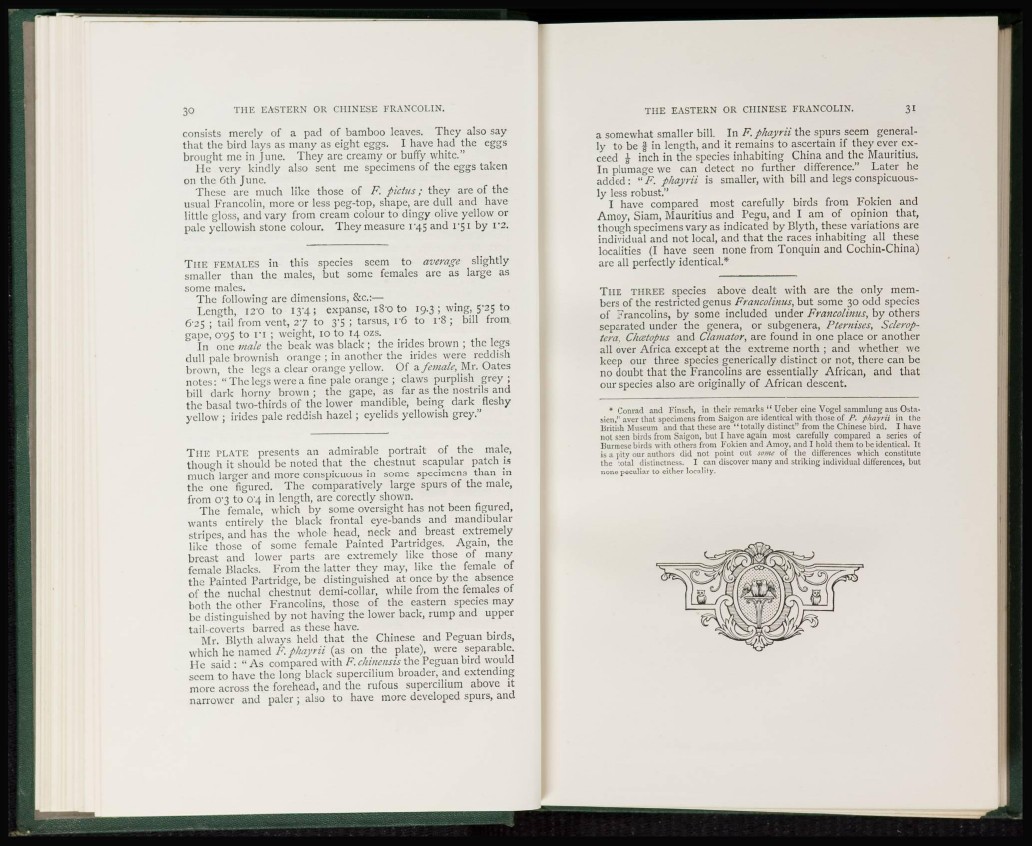
30 THE EASTERN OR CHINESE FRANCOLÍN.
consists merely of a pad of bamboo leaves. They also say
that the bird lays as many as eight eggs. I have had the eggs
brought me in June. They are creamy or buffy white."
He very kindly also sent me specimens of the eggs taken
on the Cth June.
These are much like those of F. pictus; they are of the
usual Francolin, more or less peg-top, shape, arc dull and have
little gloss, and vary from cream colour to dingy olive yellow or
pale yellowish stone colour. They measure I ' 45 and 1*51 by V2.
T H E FEMALES in this species seem to average slightly
smaller than the males, but some females are as large as
some males.
The following are dimensions, & c :—
Length, I2'0 to 13^4; expanse, i8'0 to 19.3 ; wing, 5-25 to
G'25 ; tail from vent, 2 7 to 3-5 ; tarsus, v6 to i-8 ; bill from
gape, 0'95 to r i ; weight, 10 to 14 ozs.
In one male the beak was black ; the irides brown ; the legs
dull pale brownish orange ; in another the irides were reddish
brown, the legs a clear orange yellow. Of a female, Mr. Oates
notes: " The legs were a fine pale orange ; claws purplish grey;
bill dark horny brown ; the gape, as far as the nostrils and
the basal two-thirds of the lower mandible, being dark fleshy
yellow ; irides pale reddish hazel ; eyelids yellowish grey."
T H E PLATE presents an admirable portrait of the male,
though it should be noted that the chestnut scapular patch is
much larger and more conspicuous in some specimens than in
the one figured. The comparatively large spurs of the male,
from 0'3 to 0'4 in length, are corectly shown.
The female, which by some oversight has not been figured,
wants entirely the black frontal eye-bands and mandibular
stripes, and has the whole head, neck and breast extremely
like those of some female Painted Partridges. Again, the
breast and lower parts are extremely like those of many
female Blacks. From the latter they may, like the female of
the Painted Partridge, be distinguished at once by the absence
of the nuchal chestnut demi-collar, while from the females of
both the other Francolins, those of the eastern species may
be distinguished by not having the lower back, rump and upper
tail-coverts barred as these have.
Mr. Blyth always held that the Chinese and Peguan birds,
which he named F.phayrii (as on the plate), were separable.
He said: " A s compared with F. chinensis the Peguan bird would
seem to have the long black supercilium broader, and extending
more across the forehead, and the rufous supercilium above it
narrower and paler ; also to have more developed spurs, and
THE EASTERN OR CHINESE FRANCOLIN. 31
a somewhat smaller bill. In F.phayrii the spurs seem generally
to be f in length, and it remains to ascertain if they ever exceed
J inch in the species inhabiting China and the Mauritius.
In plumage we can detect no further difference." Later he
added : " F. phayrii is smaller, with bill and legs conspicuously
less robust."
I have compared most carefully birds from Fokicn and
Amoy, Siam, Mauritius and Pegu, and I am of opinion that,
though specimens vary as indicated by Blyth, these variations are
individual and not local, and that the races inhabiting all these
localities (I have seen none from Tonquin and Cochin-China)
arc all perfectly identical.*
T H E THREE species above dealt with are the only members
of the restricted genus Fraticolinus, but some 30 odd species
of Francolins, by some included under Francolinus, by others
separated under the genera, or subgenera, Pternises, Scleroptcra,
Chcetopus and Clamator, are found in one place or another
all over Africa except at the extreme north ; and whether we
keep our three species generically distinct or not, there can be
no doubt that the Francolins are essentially African, and that
our species also are originally of African descent.
* Conrad and Finsch, in their remarks " Ueber eine Vogel sammlung aus Ostasien,"
aver that specimens from Saigon are identical with those of P. phayrii in the
British Museum and that these are "totally distinct" from the Chinese bird. I have
not seen birds from Saigon, but I have again most carefully compared a series of
Burmese birds with others from Fokien and Amoy, and I hold them to be identical. It
is a pity our authors did not point out some of the differences which constitute
the total distinctness. I can discover many and striking individual differences, but
none peculiar to either locality.